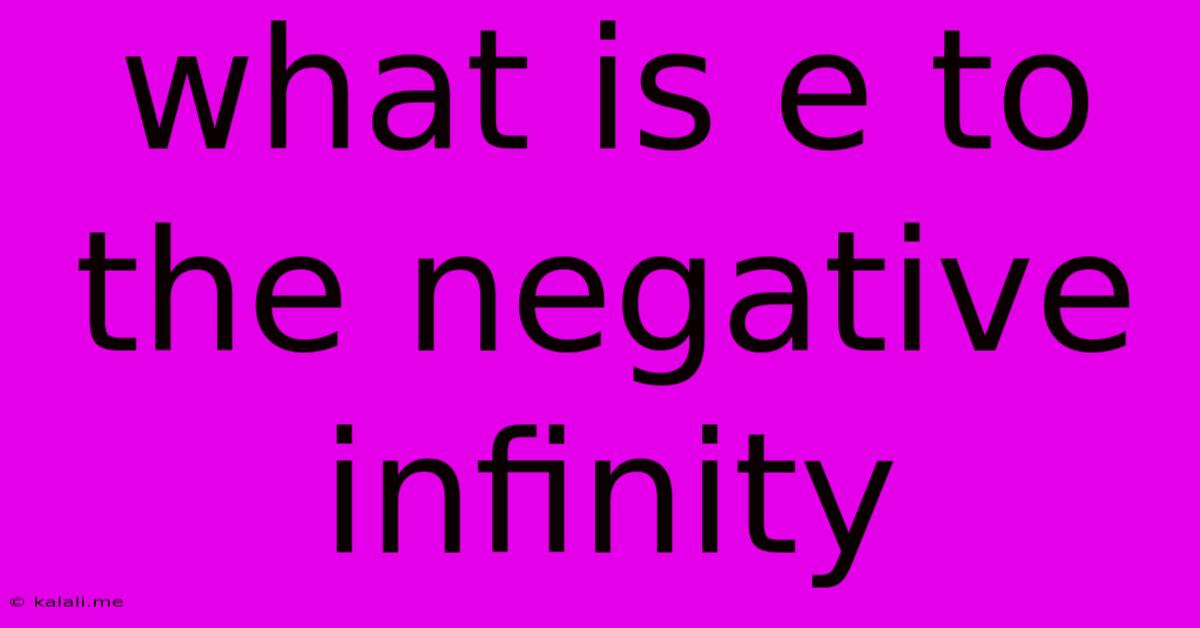What Is E To The Negative Infinity
Kalali
Jun 03, 2025 · 2 min read

Table of Contents
What is e to the Negative Infinity? Understanding Exponential Decay
This article explores the mathematical concept of e raised to the power of negative infinity, often written as e<sup>-∞</sup>. Understanding this limit is crucial for various applications in calculus, physics, and other fields involving exponential decay. We'll break down the concept in a clear and concise way, suitable for both students and those looking for a refresher.
What is e?
Before diving into e<sup>-∞</sup>, let's briefly revisit Euler's number, e. Approximately equal to 2.71828, e is a mathematical constant representing the base of the natural logarithm. It appears frequently in calculations involving exponential growth and decay. Its significance stems from its unique properties in calculus, particularly its derivative being equal to itself.
Exponential Decay and the Limit
The expression e<sup>x</sup> represents exponential growth when x is positive and exponential decay when x is negative. As x approaches negative infinity (x → -∞), the function e<sup>x</sup> approaches zero. Therefore, the limit of e<sup>x</sup> as x approaches negative infinity is 0.
Mathematically, we write this as:
lim<sub>x→-∞</sub> e<sup>x</sup> = 0
Intuitive Understanding
Imagine a quantity decreasing exponentially. With each step towards negative infinity, the quantity shrinks, becoming progressively smaller. While it never truly reaches zero, it gets infinitesimally close. This aligns with the mathematical limit, which describes the behavior of a function as its input approaches a certain value (in this case, negative infinity).
Applications
The concept of e<sup>-∞</sup> being equal to 0 has several practical applications:
-
Radioactive Decay: The decay of radioactive materials follows an exponential decay model. The amount of substance remaining after a long time approaches zero, mirroring the behavior of e<sup>-∞</sup>.
-
Probability and Statistics: Exponential distributions are used to model various phenomena, including the time until an event occurs. The probability of an event taking an infinitely long time approaches zero, again relating to the limit.
-
Electronics: The decay of voltage in certain circuits can be described using exponential decay functions.
In Summary
e<sup>-∞</sup> represents the limit of the exponential function e<sup>x</sup> as x approaches negative infinity. This limit equals zero. While the function never actually reaches zero, it gets arbitrarily close, making zero a practical and mathematically sound representation of its behavior in the limit. Understanding this concept provides a solid foundation for working with exponential decay functions in numerous scientific and engineering fields. This understanding is vital for comprehending many real-world phenomena involving exponential decline. Remember, the key takeaway is that the value approaches 0, not that it equals 0 at infinity itself.
Latest Posts
Latest Posts
-
Why Doesnt My Wife Cook Food The Way I Like
Jun 04, 2025
-
28 Days 6 Hours 42 Minutes 12 Seconds
Jun 04, 2025
-
Is The Color Gray Or Grey
Jun 04, 2025
-
What Part Of Speech Is Would
Jun 04, 2025
-
Grep Recursively Folders For Json Files
Jun 04, 2025
Related Post
Thank you for visiting our website which covers about What Is E To The Negative Infinity . We hope the information provided has been useful to you. Feel free to contact us if you have any questions or need further assistance. See you next time and don't miss to bookmark.